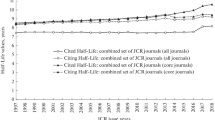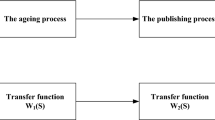Abstract
The goal of this study was to investigate the dynamics of two journals indicators (Cited Half-life and Citing Half-life) in the case of incomplete or inaccuracy data in the Journal Citation Reports. A detailed analysis of these data for the CdHL and CgHL indicators for 1997–2018 was performed. The previously formulated similarity hypothesis on journal distribution by half-life period was clarified. Methods for determining the weighted average values of half-life indicators were developed in detail. The test of the similarity hypothesis had identified the time frame within which its objectivity was certain. Results of our study revealed that the dynamics of half-life indicators were positive; moreover, and these dynamics are much more pronounced for permanently retentive journals, i.e., journals that were present in the JCR during the entire 22-year study period.


Similar content being viewed by others
Notes
If we adhere to the terminology of the JCR, then it should be said that some other publications are also taken into account in addition to articles, namely those that in principle can be cited (citable items), in particular, reviews.
These are usually the years following the year of publication of the first annual set of citing journals.
These are usually the years following the year of publication of the first annual set of cited journals.
According to the Clarivate Analytics, these two databases are the only sources of original data for the JCR. So, we read the following on the Clarivate Analytics website in the “Journal Citation Reports Help” section: “Journal Citation Reports aggregates the meaningful connections of citations created by the research community through the delivery of a rich array of publisher-independent data, metrics and analysis of the world’s most impactful journals included in the Science Citation Index Expanded (SCIE) and Social Sciences Citation Index (SSCI)…” (http://jcr.help.clarivate.com/Content/home.htm). However, as the analysis shows, a significant part of the journals reflected in the Arts & Humanities Citation Index DB, A&HCI are also represented in the JCR. As an example, the 2018 JCR issue contains 95 journals that correspond to the “History” category (let’s call these journals “history journals”), which is included in the A&HCI DB according to the Web of Science (WoS) classification. Moreover, more than half of these journals (53 out of 95) are referred by the WoS to the only category, namely, to the “History” category and only to this one. Of the remaining 42 history journals, four also belong to the “Cultural Studies” category and two belong to the “Ethic Studies” category (both categories correspond to humanitarian issues). Thus, out of 95 history journals, more than 59 (53 + 6), i.e. 62% are represented in the WoS only in the A&HCI DB. We add that 264 out of 4739 journals that were included in at least one annual issue of the JCR-SSE for the period 1997–2018 were assigned only to humanities according to the WoS classification, and the total number of journals that are devoted primarily to humanitarian problems was 315 during this period. Therefore, using the JCR, we can be sure that purely humanitarian topics and corresponding journals are included in the analysis. Note. It is possible that the opinion that the JCR does not contain the journals from the A&HCI DB is due to the fact that the JCR does not provide the impact factor values for these journals. In this regard, we note that the JCR usually presents the values of the remaining indicators, which have been “standard” in recent years for this publication (and the half-life indicators, which is especially important for the purposes of this article).
Social sciences account for 0–85% of JCR-SSE categories, and humanities account for 15–20%.
The choice of this minimum value can be justified by the fact that this will not at least lead to unreasonable overestimation of the real values of one or another half-life indicator.
Despite the fact that the mathematical apparatus, including the conversion function, was developed on the basis of an unspecified formulation of the hypothesis, this apparatus has turned out to fully correspond to the specified formulation of this hypothesis.
REFERENCES
Burton, R.E. and Kebler, R.W., The “half-life” of some scientific and technical literature, Am. Doc., 1960, vol. 11, no. 1, pp. 18–22.
Libkind, A.N., Markusova, V.A., and Libkind, I.A., Approach for using journal citation reports in determining the dynamics of half-life indicators of journals, Autom. Doc. Math. Linguist., 2020, vol. 54, no. 3, p. 174.
Libkind, A.N., Markusova, V.A., Libkind, I.A., Jansz, M., and Ivanov, K.N., Modeling the dynamics of the retentivity process of journals among the most authoritative scientific serials, Autom. Doc. Math. Linguist., 2013, vol. 47, no. 2, pp. 69–92.
Rozenberg, G.S., “Hirshness” of science and the half-life of citation of scientific ideas, Biosfera, 2018, vol. 10, no. 1, pp. 52–64.
Moskaleva, O.V., The use of scientometric indicators for the assessment of scientific activity, Naukoved. Issled., 2013, no. 2013, pp. 85–109.
Liang, G., Hou, H., Chen, Q., et al., Diffusion and adoption: An explanatory model of “question mark“ and “rising star“ articles, Scientometrics, 2020, vol. 124, pp. 219–232.
FUNDING
The study was carried out to fulfill the state assignment of the VINITI RAS on the topic 0003-2019-0001 and with the support of the Russian Foundation for Basic Research (RFBR projects 20-07-00014 and 20-010-00179.
Author information
Authors and Affiliations
Corresponding authors
Ethics declarations
The authors declare that they have no conflicts of interest.
Additional information
Translated by L. Solovyova
About this article
Cite this article
Gilyarevskii, R.S., Libkind, A.N., Bogorov, V.G. et al. Calculation of a Half-life Period of a Scientific Journal in the Case of Incomplete Data in the Journal Citation Reports . Autom. Doc. Math. Linguist. 54, 284–297 (2020). https://doi.org/10.3103/S0005105520060047
Received:
Published:
Issue Date:
DOI: https://doi.org/10.3103/S0005105520060047




